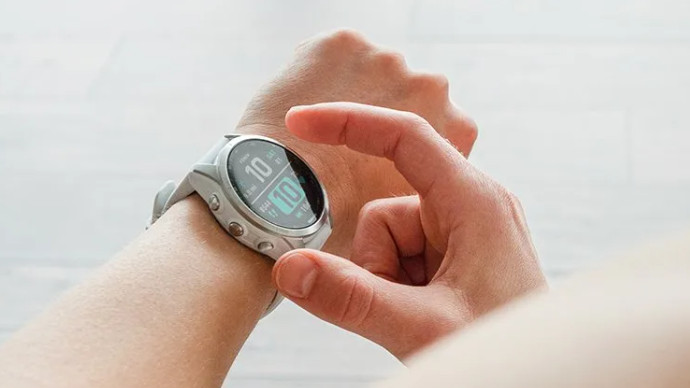
Future Garmin watches could let you touch and hold the bezel to perform an on-demand electrocardiogram (ECG) scan. A newly published patent application (application number 15/686804, available via the US Patents and Trademarks Office) describes how a next-gen Garmin watch could be designed to incorporate the necessary sensor.
Garmin has been working on an ECG app for some time. When the Garmin Venu 2 arrived earlier this year, it included hidden diagnostics hardware and an ECG app that weren't mentioned in the watch's documentation. As DC Rainmaker explains, the app was very much unfinished and likely never intended to be seen by wearers.
Now, however, we've got our first hint of how the company might design its watches around it. "The device includes electrically-conductive first and second contact points for conveying first and second signals," the abstract explains.
"The first contact point is located on a bezel or a pushbutton of the electronic device that is physically touchable by the wearer. The second contact point is located on the bottom of the housing so as to physically contact the wearer's skin of the user's wrist when the device is worn."
Is Garmin late to the party?
Garmin certainly won't be the first watchmaker to incorporate ECG sensors into its devices. Apple added the tech to the Apple Watch 4 in 2018, and others including Fitbit, Samsung, Withings, and Coros have all followed suit. The idea is to make it easy to perform a check that will highlight signs of an irregular heartbeat, or atrial fibrillation, which could be an early warning of heart disease.
So why has Garmin been so slow to join in? It might be partly due to the type of people who use its watches. Although anyone can develop heart disease, the type of active, relatively young people who opt for a Garmin watch are likely to be at relatively low risk.
“ECG on wearables is super high value for a small segment," Dr Conor Heneghan, Director of Research Algorithms at Fitbit told Wareable in an interview "It is probably going to be more advantageous to our users over 50 than 20 year olds."
All the latest inspiration, tips and guides to help you plan your next Advnture!
Wrist-based ECG monitors also have the disadvantage that they have to be activated manually, and you have to sit with your fingers on the watch while the scan is completed. To avoid that problem, Fitbit is currently working on technology for passive ECG monitoring, which can perform regular scans throughout the day without you having to take time out. As Engadget explains, Fitbit's parent company Google seems to be pressing ahead, and has submitted the tech to the US Food and Drugs Authority (FDA) for approval.

A patent application isn't a guarantee that the tech will make its way into a finished device, but the fact that Garmin has conducted a clinical study on its own ECG software algorithm suggests it's more than likely.
It doesn't sound like the company is planning to change the look of its best GPS watches, though. According to the patent application, one contact point will be on the back of the watch case, while the other could be built into one of the five buttons that adorn its Forerunner and Fenix watches.

Cat is the editor of Advnture, She’s been a journalist for 15 years, and was fitness and wellbeing editor on TechRadar before joining the Advnture team in 2022. She’s a UK Athletics qualified run leader, and in her spare time enjoys nothing more than lacing up her shoes and hitting the roads and trails (the muddier, the better), usually wearing at least two sports watches.
